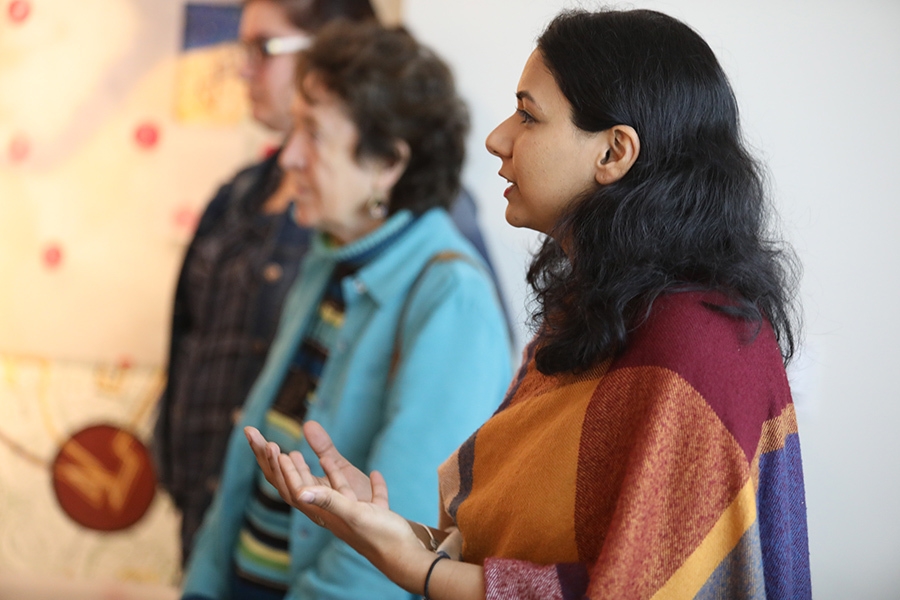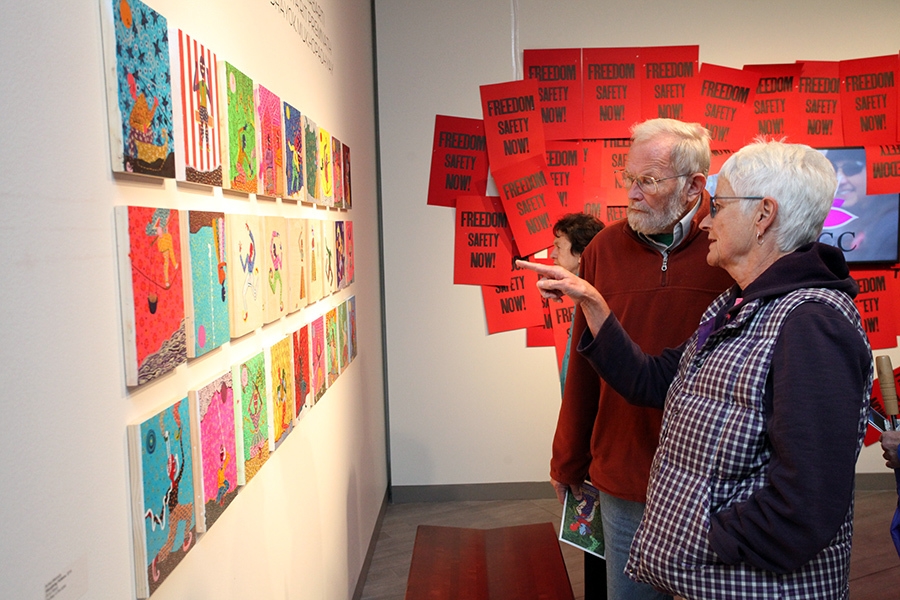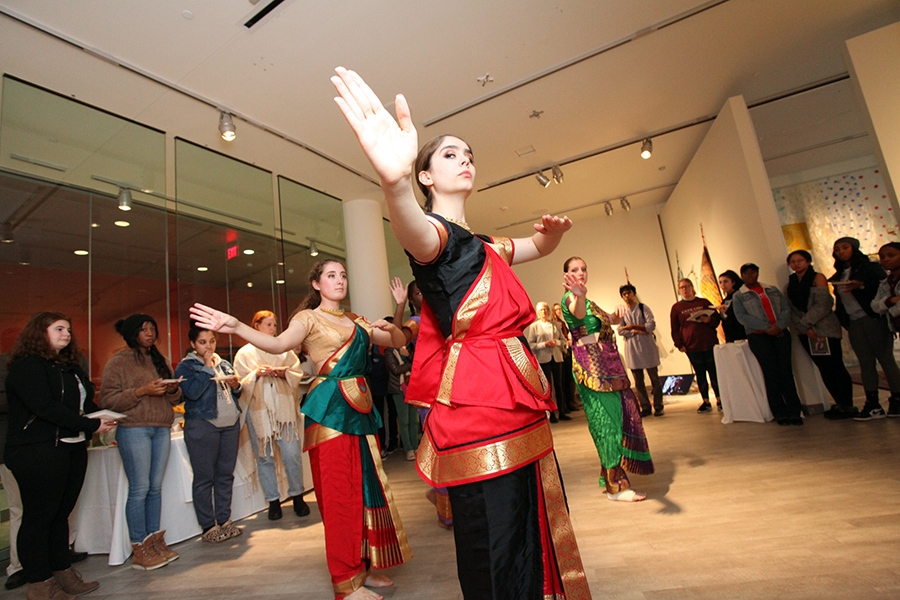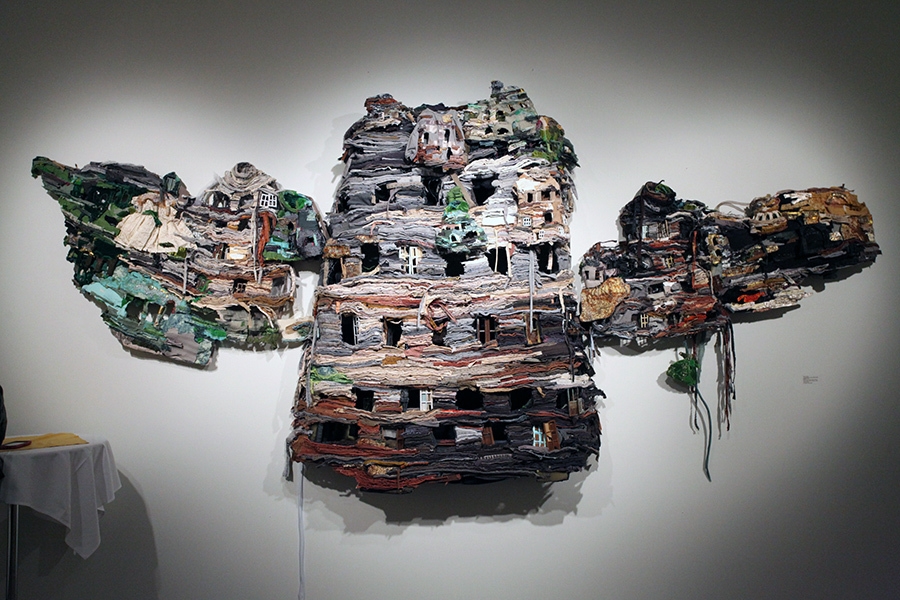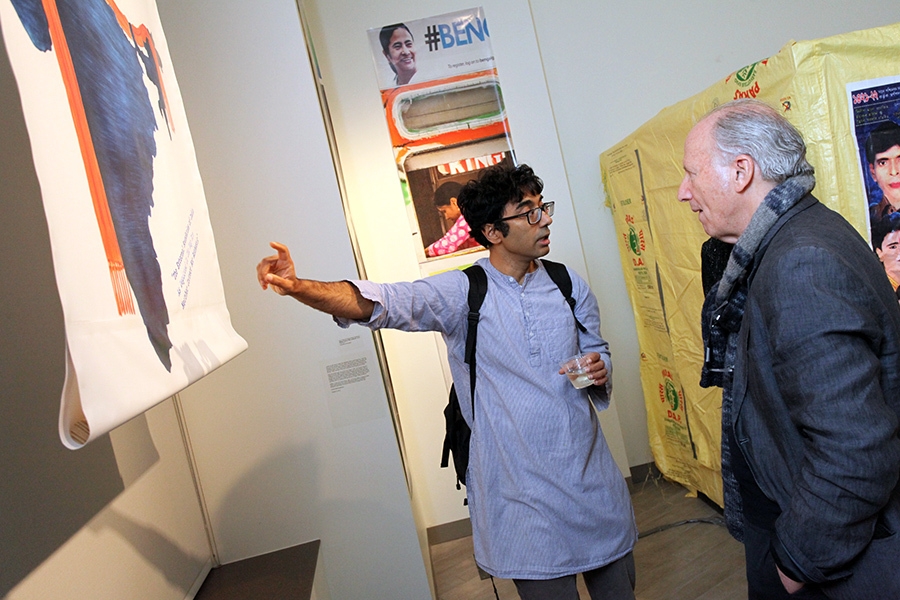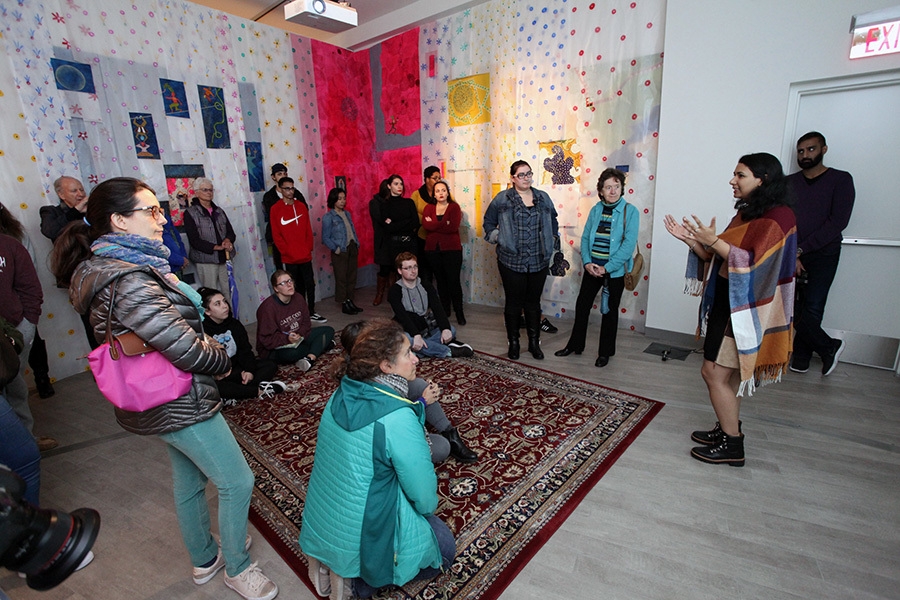- Apply
- Visit
- Request Info
- Give
Eastern Art Gallery Presents ‘Happiness Curriculum’
Written by Molly Boucher
Published on October 23, 2019
The Art Gallery at Eastern Connecticut State University is showing its second exhibition of the year, “The Happiness Curriculum: Art from the South Asian Diaspora,” from Oct. 17-Dec. 14. The gallery opened with a talk and reception on Oct. 17 with featured artist Ruhee Maknojia. Shayok Mukhopadhyay, creator of the film “Gautam & Buddha,” also attended the event. Students and guests explored Maknojia’s and Mukhopadhyay’s immersive art as well as the work of the four other artists, which express the different aspects of living in south Asia.
“The Happiness Curriculum,” which was ironically named for a 45-minute meditation initiative in Indian schools to decrease anxiety, depression and intolerance in students, comments on the many different aspects of life in south Asia. While some artists focus on issues of sexual violence, others focus on the beauty of the Mogul gardens. Social, geographical and emotional issues are discussed in the exhibition through different forms of media, ranging from film to immersive art.
The work of Maknojia, an interdisciplinary artist, is presented throughout the gallery space. Coming from Austin, TX, Maknojia creates art inspired by everyday reality. Among the most impactful elements of her display is the immersive “garden,” set up in a sectioned-off room in the art gallery. The room, which is covered in oil-painted canvases layered with glassine paper, shows the theme of the garden. “I try to create this perfect world for myself,” said Maknojia.
Each part of the experience had a specific purpose, such as the rug Maknojia encouraged guests to sit on, or the video that showed perfect geometric shapes aligned with traditional south Asian music. The glassine paper that Maknojia used to cover the oil paintings also had a specific purpose. Covered in small and simple plant-themed designs, the paper had sections cut out to expose the oil canvases hidden underneath. Maknojia said this was done with the idea that “as people, we are quite layered.” With the goal of showing a garden-her dream world-and how it interacts with the human experience, Maknojia’s work investigates the fragile spaces between life and death. She also had two other oil paintings on display, once again showing characters within her garden theme, which stems from the Mogul gardens around India and Pakistan.
Mukhopadhyay, a photographer and producer, also utilizes immersive artwork. A small box-shaped structure covered by a tarp sat in the gallery, with many students and observers alike walking by to examine it. It wasn’t until the students realized they could touch the work that they drew back the curtain. Inside the structure was a television that played Mukhopadhyay’s film, “Gautam & Buddha,” along with tapestries and a wooden bench for observers to sit on and watch the movie. The film follows two rural gay men, Gautam and Buddha, while they travel through India playing women. Mukhopadhyay will show the film on Oct. 29 at 7 p.m. in the Student Center Theatre, and on Oct. 30 he’ll speak about his films and upbringing in Calcutta, India, at 3 p.m. in the theatre.
Other artists whose work was displayed in the gallery included Swati Khurana, who shows her protests against sexual violence through a series of bright red posters with the words “Freedom. Safety. NOW.” These posters surrounded a television showing her protest activity in front of the Indian consulate in New York City. The protest and art were a response to the rape and death of Pandey, a young woman who was gang-raped on a New Delhi bus in December 2012. Khurana will be on campus on Nov. 6 at 3 p.m. in the Student Center Theatre to speak about the protest.
Kanad Chakrabarti, who presents large maps of the Mediterranean to show the regression from what used to be a prosperous sea to one that is now pollutied and overfished. The maps are hung and combined with rope and other fishing products to show the shift in our relationship to the ocean.
Ruby Chishti uses recycled textiles, wood, thread, metal scraps, wire mesh and archival glue to showcase “The Present… is a Ruin without the People.” Combined with an audio recording, the piece shows the physical and emotional spaces that were unwillingly abandoned in times of war and conflict. With a focus on destruction and reconstruction, Christi hand sewed thousands of layers of recycled products.
Sreshta Rit Permnath presents his project “Slump,” which shows a piece of tar and sand in a limp structure that was held up by a piece of architecture. The goal of this piece is to show how certain materials respond to the structure that holds them up-whether it’s needed for support or is constrained by it.
Eastern will host several additional events related to “The Happiness Curriculum.” On Oct. 24 at 4:30 p.m. in the Art Gallery, Professor Kathryn Myers, an art professor at the University of Connecticut, will lecture on her contemporary work centered around south Asian culture. On Oct. 29 at 7 p.m. in the Student Center Theatre, Mukhopadhyay will show his film “Gautam & Buddha”; he’ll also speak in the theatre on Oct. 30 at 3 p.m. Finally, on Nov. 6 at 3 p.m. in the Student Center theatre, Khurana will discuss her protests regarding sexual violence in India.
The Art Gallery is located at room 112 in Eastern’s Fine Arts Instructional Center. Admission is free. Gallery hours are Tuesday-Wednesday from 11 a.m.-5 p.m., Thursday from 1-7 p.m., and Saturday-Sunday from 2-5 p.m. For more information, contact the Art Gallery at (860) 465-4659, visit www.easternct.edu/artgallery or email Yulia Tikhonova, gallery director, at tikhonovay@easternct.edu.



